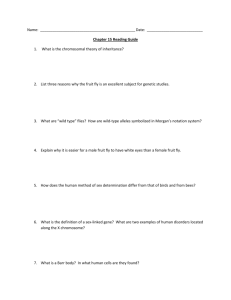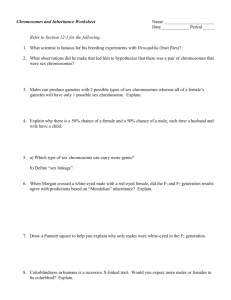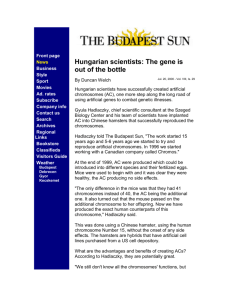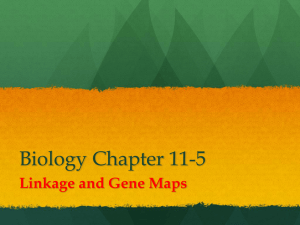Ch. 15 Reading Guide 9th edition
advertisement
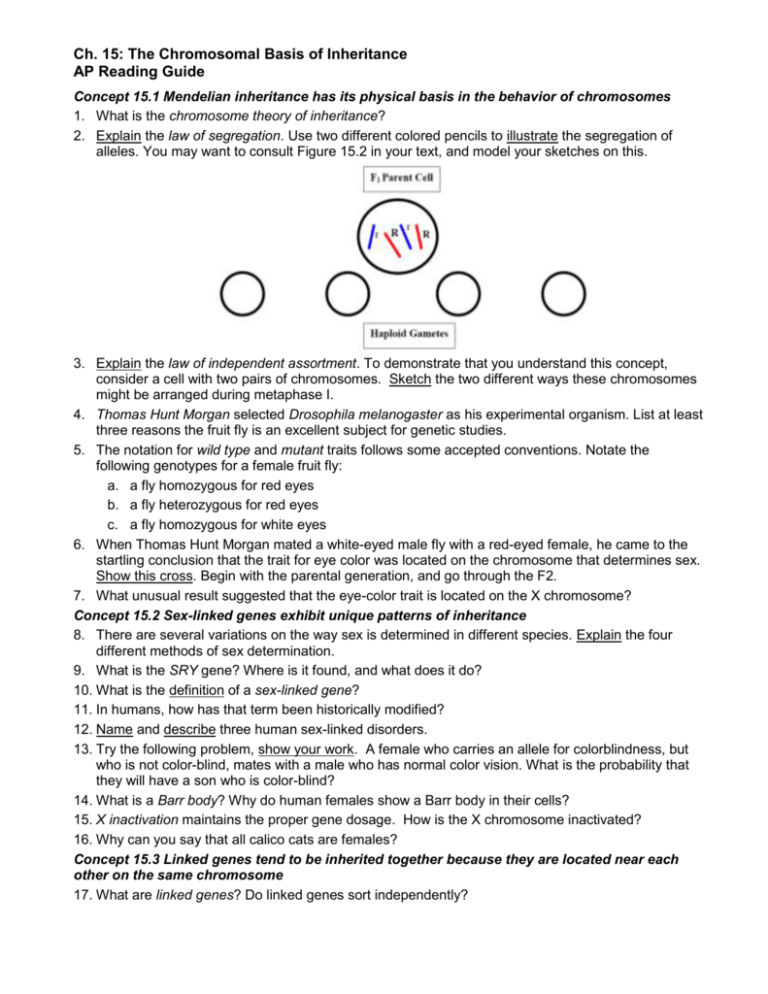
Ch. 15: The Chromosomal Basis of Inheritance AP Reading Guide Concept 15.1 Mendelian inheritance has its physical basis in the behavior of chromosomes 1. What is the chromosome theory of inheritance? 2. Explain the law of segregation. Use two different colored pencils to illustrate the segregation of alleles. You may want to consult Figure 15.2 in your text, and model your sketches on this. 3. Explain the law of independent assortment. To demonstrate that you understand this concept, consider a cell with two pairs of chromosomes. Sketch the two different ways these chromosomes might be arranged during metaphase I. 4. Thomas Hunt Morgan selected Drosophila melanogaster as his experimental organism. List at least three reasons the fruit fly is an excellent subject for genetic studies. 5. The notation for wild type and mutant traits follows some accepted conventions. Notate the following genotypes for a female fruit fly: a. a fly homozygous for red eyes b. a fly heterozygous for red eyes c. a fly homozygous for white eyes 6. When Thomas Hunt Morgan mated a white-eyed male fly with a red-eyed female, he came to the startling conclusion that the trait for eye color was located on the chromosome that determines sex. Show this cross. Begin with the parental generation, and go through the F2. 7. What unusual result suggested that the eye-color trait is located on the X chromosome? Concept 15.2 Sex-linked genes exhibit unique patterns of inheritance 8. There are several variations on the way sex is determined in different species. Explain the four different methods of sex determination. 9. What is the SRY gene? Where is it found, and what does it do? 10. What is the definition of a sex-linked gene? 11. In humans, how has that term been historically modified? 12. Name and describe three human sex-linked disorders. 13. Try the following problem, show your work. A female who carries an allele for colorblindness, but who is not color-blind, mates with a male who has normal color vision. What is the probability that they will have a son who is color-blind? 14. What is a Barr body? Why do human females show a Barr body in their cells? 15. X inactivation maintains the proper gene dosage. How is the X chromosome inactivated? 16. Why can you say that all calico cats are females? Concept 15.3 Linked genes tend to be inherited together because they are located near each other on the same chromosome 17. What are linked genes? Do linked genes sort independently? 18. If two genes are linked on the same chromosome, we call this combination the parental combination. These genes will be transmitted as a unit and will not sort independently. However, during meiosis, crossing over occurs between homologous chromosomes, and the linked genes can become “unlinked.” In general, the farther two genes are from each other along the chromosome, the more often they will come “unlinked.” Genetic recombination is the process during which linked genes become unlinked. What do geneticists call the offspring that show these new combinations? 19. Review meiosis. When does crossing over occur? 20. Alfred H. Sturtevant, a student of Thomas Hunt Morgan, used assumptions from observations of crossovers to map genes. What is a linkage map? 21. What is a map unit? 22. Study Figure 15.10. It shows the results of a cross between a fruit fly that is heterozygous for gray body with normal wings, and a fruit fly that has a black body with vestigial wings. Because these genes are linked, the results are not what might have been predicted. Calculate the map distance between the two genes. Show all your work. Concept 15.4 Alterations of chromosome number or structure cause some genetic disorders 23. What occurs in nondisjunction? 24. Explain each of the following terms: aneuploidy, monosomy, trisomy, and polyploidy. 25. Which of the events described in question 24 results in Down syndrome? What are four characteristics of Down syndrome? 26. For each of the following human aneuploidies, identify the sex of the individual as well as describe any physical manifestation of the syndrome: XXY, XXX, XO, and XYY. 27. Chromosome structure can be altered in several ways. Explain what occurs in each type of alteration: deletion, duplication, inversion, translocation. Concept 15.5 Some inheritance patterns are exceptions to the standard chromosome theory 28. A number of genes will cause a variation in phenotype, depending on whether the gene came from the father or the mother. This variation occurs because of genomic imprinting. Explain genomic imprinting. 29. Although you inherited one chromosome of each pair from your mother and your father, you have inherited a group of genes from your mother only. What genes are these? 30. What other organelle has its own genes? These are extranuclear genes.



